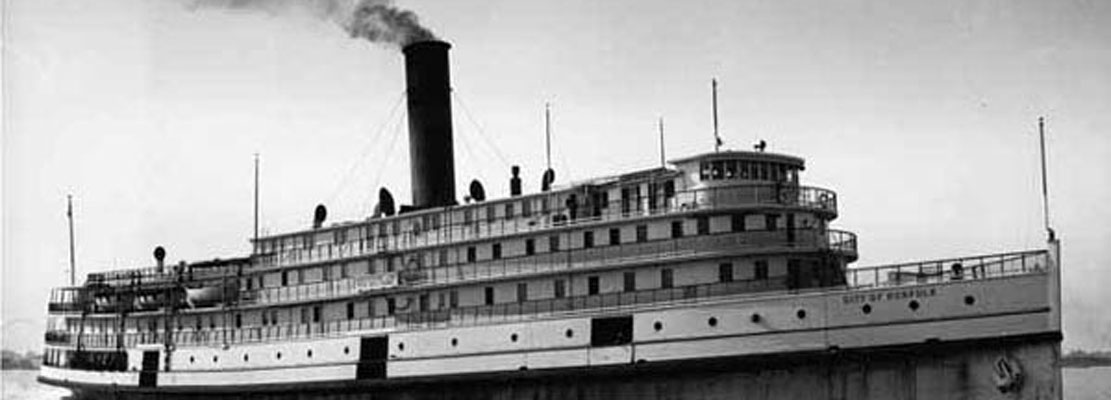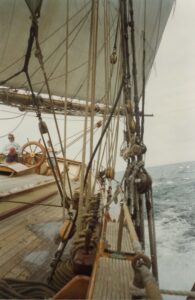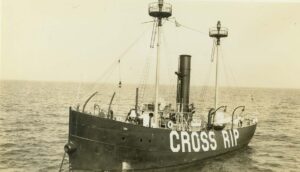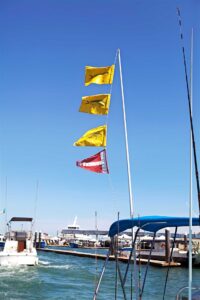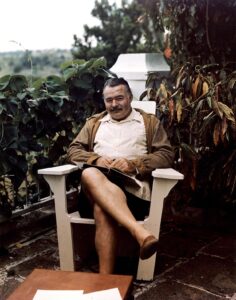As soon as they saw puffs of smoke rise above the trees at the river’s bend and heard the blast of a ship’s whistle, townsfolk rushed at breakneck speed to the wharf. From farmers, watermen and preachers to housewives and especially children, everyone knew when the steamboats of the Chesapeake Bay arrived in the remote waterside village.
What caused all this ruckus? Keep in mind that land travel at the dawn of the 19th-century was inconvenient. Trains were just starting to chug out of urban pockets, horse-drawn stagecoaches rattled across dusty roads, and automobiles hadn’t yet entered the transportation scene.
The best way to link growing populations between Baltimore and Norfolk was to master the water. And so a new era of mass transit began in the Chesapeake Bay in 1813 when a Baltimore shipyard built the first local steamboat. “Over the next 120-plus years, the fleet would swell to nearly 600 vessels that reached 300
locations in an intricate network crisscrossing the Bay,” says Barbara Brecher, executive director of the Steamboat Era Museum in Irvington, Virginia.
Steamboats on the Chesapeake Bay changed everybody’s lives in the region. Farmers and fishermen expanded their markets by shipping wares to urban consumers. Once-isolated rural folks received the latest fashions, machinery, books, mail and more. They could travel easily to cities to conduct business, go shopping or visit doctors. Their urban counterparts gained access to new buyers for manufactured goods, welcomed the arrival of fresh foods and cruised to picturesque parts of the Bay to escape city life.
This waterfront boom wasn’t just about commerce. Steamboats were also built for fun. By the mid-1800s, many ship companies wanted a piece of the Chesapeake pie and competed for customers by promising hard-to-resist amenities and attractions. Floating theaters delivered entertainment to arts-starved small towns, while moonlight dance cruises brought music to sleepy harbors. Many companies lured travelers with luxurious staterooms decked out with velvet, crystal and brass, and meals served on linendraped tables. A Chesapeake Steamship Co. menu from 1900 kicked off with oysters prepared five different ways, followed by steak, tongue, lamb, chicken, soft-shell crabs and lobster salad.
SURVIVING WAR-TORN AMERICA
After decades of amiable trade between the industrial North and agrarian South, the Civil War’s maritime restrictions caused the Bay’s steamboat routes to turn murky.
When President Lincoln set up blockades in Southern ports to curb the flow of goods and weapons to the Confederacy, access to Norfolk was cut off and travel between Baltimore and Richmond came to a screeching halt. Old Point Comfort became the boats’ last stop south. Fortunately, steady traffic between Washington officials and Navy facilities in Virginia’s Tidewater region kept steamboat companies afloat during this difficult time.
Postwar conditions created a favorable climate for steamboats. As the South rebuilt its communities, construction materials and life necessities were loaded into boats’ hulls and carried south. Cargo traffic bloomed, and a heyday even grander than before ensued. Once again, travelers were courted with lavish, swanky ships. Galley chefs dazzled passengers with feasts of local duck and terrapin. Revelers danced their way around the Bay to Big Band tunes on evening cruises.
Along the Eastern Shore, Potomac River and other destinations, savvy steamer companies developed amusement parks where city dwellers could find relief from the sweltering heat. One of the most famous was Tolchester Beach, which opened in 1887 in Maryland’s Kent County north of Rock Hall. Every summer day, thousands of Baltimore passengers took a short steamboat trip across the water carrying bathing suits and picnic baskets. Tolchester eventually grew to 150 acres and offered vacationers a hotel, beach, music pavilion, horse racing, roller coaster, merry-go-round and other fun-filled attractions. By the turn of the century, six steamboats ferried about 20,000 revelers there and back each weekend.
RUNNING OUT OF STEAM
Steamboats reached such popularity that it was hard to imagine life and commerce on the Bay without them. But the deck was stacked against the ships, and fate dealt more bad cards than they could handle. They paddled through World War I relatively unscathed, but the Great Depression shrunk passenger rosters and
put a dent in the steamers’ revenue stream. In 1933, a Category 4 hurricane shattered many of the wharfs and washed away scores of boat landings.
During World War II, the War Shipping Administration gained the power to expropriate civilian-owned ships, and seized the cream of the steamboat crop for the nation’s defense. Many of the pilfered steamboats were sunk abroad or sustained extensive damage that was too costly to repair.
The knockout blow came from planes, trains, automobiles and bridges. Post- WWII America became infatuated with modern transportation. Superhighways replaced bumpy dirt roads, and bridges spanned waterways where ferryboats once reigned. Railroads could transport more cargo and people longer distances across the continent than watercrafts. The 12-hour cruise down the Chesapeake Bay seemed slow and outdated compared to speedy new modes of travel.
The remaining steamboat companies tried to win back the hearts of their passengers. They ran ads extolling the romance of adventure on the water and the benefits of a leisurely cruise. Vessels were reconfigured to carry cars, but travelers’ interest was lukewarm and ticket sales sunk. In 1962, steamboat service on the Bay ended, as did an era of elegance on the Chesapeake Bay.
To experience life during this extraordinary time, and to see Chesapeake Bay Steamboats, visit the Steamboat Era Museum in Irvington, VA (steamboateramuseum.org).

